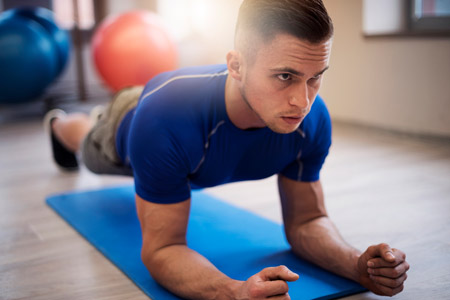Pilates may look simple, but it takes a lot of precision and control with a strong emphasis on technique.  The benefits of pilates are many as breathing and concentration can be improved, the movements can target every area of the body and the exercise is low impact. Most trainers define low-impact exercises as motions where one foot stays on the ground at all times. These types of exercises potentially reduce the risk of injury and place less stress on the body—making them an ideal workout for people who have joint problems.
The benefits of pilates are many as breathing and concentration can be improved, the movements can target every area of the body and the exercise is low impact. Most trainers define low-impact exercises as motions where one foot stays on the ground at all times. These types of exercises potentially reduce the risk of injury and place less stress on the body—making them an ideal workout for people who have joint problems.
What is Pilates?
Pilates is an exercise with emphasis on your body’s core. It’s a conditioning program that improves deep core strength, muscle control, flexibility, posture and coordination, while producing muscular endurance. It has six principles:
Centering
By paying attention to your body’s core, e.g., the abdomen, obliques, lower back, inner and outer thighs and glutes, you will help your muscles function and develop where you desire.
Concentration
Concentrate on your body’s form as you make each movement. By focusing on your mind-body awareness, you will reap the benefits from your workouts because of the better connection you’ve established with your body.
Control
Control is the key to performing these exercises correctly. Speed and repetition are of less concern than precision.
Precision
Keep practicing. Watch yourself in a mirror or have a trainer critique your movements. Proper form is essential to ensure you’re getting the most out of your workout.
Breathing
Stay focused by controlling your breathing with deep inhalations and exhalations. By breathing properly, you can help your body activate the correct muscles and remain concentrated.
Flow
Think of a dancer’s form while doing Pilates. Movements should be graceful, smooth and in a continuous manner.
Develop a Strong Core
While Pilates does provide a full body workout, its main focus is to develop a strong "core," or center of the body. The core muscles includes the erector spinae, traverse abdominis (TVA), obliques and lowerlats, which work together as stabilizers for the entire body. Core stability can protect the spine and surrounding musculature from injury.
Learn How to Move Efficiently
Pilates exercises train many muscle groups at once in slow, steady and continuous movements. Retraining your body’s movements into safer, more efficient patterns of motion can be achieved by working on proper technique and form. This is helpful for improved posture, sports performance, injury recovery and good health.
Gain Muscle Endurance and Flexibility
Due to the steady movements of Pilates without the use of heavy weights, this workout can elongate muscles and provide them with endurance and elasticity. Because Pilates is a low impact exercise, joint mobility is increased while the risk of injury is decreased—making it an ideal workout for people with slight injuries, joint pain or other ailments.
A Refreshing Mind-Body Exercise
In Pilates, you must use your mind. Proper breathing is essential to help you execute movements with the correct form. Mind-body exercises have a system of utilizing the breath, and specific breathing patterns to improve technique and maximize benefits—requiring concentration, balance, coordination and body control. By practicing proper breathing techniques, you can reduce stress and become acutely in tune with your body.
New to Pilates and wondering how to get started? Visit our Group Fitness Classes page to find a Pilates class at your favorite location.
